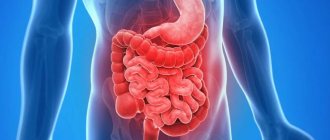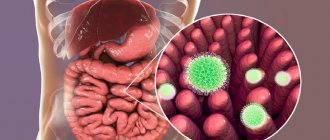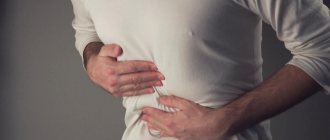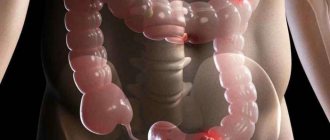Read more about the causes of discomfort
Discomfort detected in the intestines or stomach is a reason to consult a doctor. The fact is that the reasons that can provoke the appearance of unpleasant sensations in this area are diverse.
As a rule, factors such as an unbalanced diet, an unhealthy lifestyle, or any diseases of an inflammatory or destructive nature can provoke the occurrence of various pathologies of the gastrointestinal tract.
You can read more about these reasons below.
Useful article? Share the link on VKontakte
Problems in the stomach or intestines caused by poor nutrition are characterized by symptoms such as epigastric pain, gas formation, abdominal bloating, diarrhea, nausea and vomiting.
As a rule, treatment of such pathologies involves taking probiotics, as well as following a fairly strict diet.
In some cases, to neutralize discomfort in the stomach or intestines, special preparations rich in digestive enzymes are prescribed, as well as agents that cleanse the human intestinal system of waste and toxins.
A common cause of bloating and pain localized in the abdominal area is dysbacteriosis.
The following reasons can cause this pathological condition:
- uncontrolled and prolonged use of antibiotics;
- prolonged strict diets;
- alcohol and tobacco abuse.
There are specialized drugs that help restore intestinal microflora quickly and relieve people of symptoms such as bloating.
Other causes that provoke pain in the stomach and intestines, as well as bloating in the abdominal area, are gastrointestinal diseases (pancreatitis, liver pathologies, ulcers) and irritable bowel syndrome.
To find out what pathology provokes pain in the intestines and bloating, you should visit a doctor and undergo a series of diagnostics.
The treatment that will be prescribed after such studies will allow you to forget about unpleasant symptoms and normalize the functioning of the body.
As a rule, doctors send patients complaining of pain in the stomach and intestines, as well as bloating in the abdominal area, for studies and diagnostics such as FGDS, bacterial stool cultures, coprograms, colonoscopies and endoscopies.
Video about feeling discomfort in the stomach
When discomfort occurs in the abdomen, it is better to look for the cause immediately. The feeling of discomfort, even severe painful phenomena, can be provoked by factors that are incomprehensible at first glance. How and with what to treat bloating, remove gas, heaviness, solve the problem of belching - all this is explained in an accessible video format. Those who carefully follow the recommendations presented below will be able to help themselves or their loved ones by eliminating discomfort and identifying signs of disruption of the digestive system.
Can IBS be cured?
Irritable bowel syndrome.
Why does bloating occur?
Bloating - causes and treatment
How to remove gases
Attention! The information presented in the article is for informational purposes only. The materials in the article do not encourage self-treatment. Only a qualified doctor can make a diagnosis and give treatment recommendations based on the individual characteristics of a particular patient.
Article updated: 04/03/2020
This is interesting: Medicine for liver cirrhosis: what medications can stop the disease?
Treatment of intestinal pathologies
Symptoms characteristic of various intestinal pathologies (relevant for both adults and children):
- sharp or dull pain localized in the lower abdomen (can radiate to the first third of the abdominal region);
- nausea, sometimes vomiting, which usually does not bring relief;
- diarrhea or constipation;
- elevated temperature (in the presence of inflammatory processes);
- apathy, refusal to eat, drowsiness, etc.
It is important to understand that such symptoms can indicate both the presence of mild dysbiosis and the presence of more serious pathologies (including intestinal cancer).
Of course, severe diseases have more “impressive” and vivid symptoms, but this is how they begin.
Video:
In order to identify the pathology in time and begin its adequate treatment, you should visit a doctor and under no circumstances begin independent treatment, hoping that the symptoms affecting the quality of life will go away on their own.
As mentioned above, proper treatment of any intestinal pathology involves taking special medications with a different spectrum of action, as well as following a diet that normalizes metabolism in the human body.
This diet implies constant control over nutrition and an almost complete rejection of foods that cause bloating and pain caused by difficulty digesting “heavy” foods.
When should you start following such a diet? Immediately after the disease causing the appearance of unpleasant symptoms is identified.
As part of a therapeutic diet, you should avoid foods rich in complex carbohydrates, which are found in abundance in sugar and sweets, as well as carbonated drinks.
In addition, you need to significantly reduce the consumption of flour, fried and fatty foods, and add foods such as vegetables, fruits and cereals to your diet.
You need to stick to the diet until all the symptoms of the pathological process localized in the body disappear, as well as for some time after complete recovery.
Treatment of pathologies that cause discomfort in the stomach and intestines, in the vast majority of cases, involves taking enzymatic preparations.
The most popular products enriched with these “digestive” components are “Festal”, “Mezim”, “Motilium”, etc.
Treatment for dysbacteriosis also includes special drugs, such as Florin Forte, Linex, Actobacterin, Biobakton, Acylact, etc.
It is worth noting that many of the drugs mentioned in this article can be used not only when the feeling of discomfort in the intestines becomes significant, but also when you simply want to normalize the functioning of your body.
Causes of Frequent Passing of Gas
Passing gas after bloating rarely appears in the morning. As a rule, they grow during the day and intensify in the evening. Determining the causes of bloating is not always easy. However, experts believe that the whole point is in the ingredients that have not been treated with digestive enzymes. The resulting chemical reaction contributes to the release of odorous gases, which consist of carbon dioxide, hydrogen, methane and nitrogen.
The air that comes in while eating and drinking provides an oxygen mixture that facilitates fermentation and increases the amount of gas produced. When there is too much of it in the stomach and intestines, bloating and excessive gas production occurs.
Additional recommendations for intestinal discomfort
By the way, treatment of intestinal pathologies that are mild and not dangerous to human life can be carried out using various folk remedies, such as decoctions of medicinal herbs and freshly squeezed vegetable juices.
To prepare a remedy that alleviates abdominal pain, you need to add three tablespoons of peppermint to half a liter of water.
The resulting decoction should be consumed warm two to three times a day, twenty to thirty minutes after meals. A similar drink can be prepared using medicinal chamomile.
These remedies can be used on an ongoing basis to enhance the body’s own immunity and normalize the functioning of the intestinal system.
Another folk “medicine” indicated for intestinal discomfort can be made by squeezing the juice from two or three thoroughly washed but unpeeled potatoes.
It is better to drink this juice before meals, ten to twenty minutes.
You can get rid of sudden discomfort localized in the intestinal area by performing therapeutic exercises or massage of the abdominal area, carried out strictly in a clockwise direction.
It should be noted that in the presence of sharp pain or immediately after eating, you should not resort to physical activity or massage, so as not to provoke a deterioration in your own well-being.
Video:
After reading this article, you were able to learn about what to do if you experience severe discomfort localized in the stomach or intestines.
Constant discomfort characteristic of this area is a reason to consult a gastroenterologist.
The treatment that the doctor will prescribe after diagnosing the condition will allow you to quickly get rid of unpleasant symptoms.
All systems of the human body are interconnected and depend on each other for proper functioning. When pain occurs in the lower abdomen, it can be provoked by several organs at once. People often complain that their intestines hurt in the lower abdomen. You need to understand what paroxysmal, throbbing, bursting, cutting pain means, and what to do with it.
Diagnostic methods
Before treating stomach discomfort, it is necessary to find out the cause of its occurrence. For this purpose, they contact a gastroenterologist and undergo a comprehensive examination. It is important to find out whether the disorder is associated with pathological conditions - ulcers, gastritis, pancreatitis. To do this, the following diagnostic procedures are carried out:
- ultrasound examination of the gastrointestinal tract;
- X-ray pictures;
- laboratory tests of blood and urine.
If there is discomfort in the stomach area, phagogastroduodenoscopy is performed using a probe. The technique evaluates the condition of the mucous membrane of the internal organ.
What can hurt in the lower abdomen?
There are many organs in the lower part of the human torso. Each of them can cause pain. The main, primary task in treatment is to determine the source of inflammation. They can be:
- stomach;
- appendix;
- intestines;
- reproductive organs or genitourinary system;
- spleen.
Sharp pain in the lower abdomen
More often, sharp painful attacks are caused by irritable bowel syndrome; cutting discomfort has varying degrees of intensity (from mild to acute), often becoming stronger after eating. The disease is accompanied by the following symptoms:
- feeling of incomplete bowel movement;
- bloating;
- constipation;
- flatulence;
- diarrhea;
- “lump in throat” when swallowing;
- muscle pain;
- nausea.
Cramping pain in the lower abdomen
Such sensations are usually caused by obstruction of the colon. It may occur due to a failure in the movement of its contents through the intestines. The main symptom will be cramping pain, bloating, and less commonly:
- vomit;
- loss of appetite;
- absence, stool retention.
Contractions usually occur every 15 minutes. If you do not pay attention to these symptoms, then after 3 days they will disappear, but this should alert the patient even more. Such changes may indicate a cessation of intestinal motility, which can lead to intoxication and death. In such a situation, immediately consult a doctor at the hospital.
Pain in the lower abdomen on the right
In most cases, inflamed appendicitis creates discomfort in the right side. Initially, the pain is spread throughout the stomach area in the middle, but later it appears in the lower abdomen and is concentrated on the right. The pain intensifies when turning over from one side to the other, walking or coughing. Over time, tension will arise below, which is an important signal to go to the hospital. The person will constantly feel sick, the temperature and blood pressure will rise, there will be an appetite disorder, and loose stools.
Pain in the intestines on the lower left side
Often people, when meeting with a doctor, say that they have pain in the left lower abdomen. This localization of discomfort may indicate a number of diseases:
- Irritable bowel syndrome. The cause of the disease is unclear, but many argue that stress causes it. It appears in men and girls of any age, but is more common in women over 30. Pain in the intestines on the lower left side is chronic and can be accompanied by constipation, flatulence, and diarrhea.
- Crohn's disease can cause pain in the left lower abdomen. This is an inflammatory process of the gastrointestinal tract that occurs in the descending colon.
- Hirschsprung's disease. This is a hereditary pathology that boys are more susceptible to. The disease is characterized by the absence of areas of innervation in limited, individual areas of the large intestine.
Pain in the intestines after eating
Abdominal pain after eating is most often caused by indigestion, food intolerance, gastric reflux or peptic ulcers. However, if it is concentrated in the intestines, it may be a symptom:
- irritable bowel syndrome ,
- Crohn's disease is an inflammatory bowel disease. This leads to ulceration of the mucous membranes, which prevents them from working properly. The reasons are unknown. Manifested by anemia, fever, diarrhea with a lot of mucus. Treatment requires the use of anti-inflammatory and immunosuppressive drugs, as well as proper nutrition,
- Ulcerative colitis is an inflammatory bowel disease . The disease causes ulceration of the mucous and submucous membranes of the colon. The reasons are unknown. It manifests itself as abdominal pain, fever, weight loss, severe diarrhea or constipation. Treatment requires the use of pharmaceuticals and in some cases surgery is necessary.
These conditions may also be associated with constipation, diarrhea, gas and malaise.
Causes of pain in the lower abdomen
If discomfort occurs in the lower part of the body, it is important to determine the nature of the pain and symptoms in order to properly treat the disease. Depending on the root cause, the doctor may prescribe one or another remedy. No less important is the provoking factor (cause), which caused a dull, pulling, cutting pain below. As a rule, it lies in the intestines, which ceases to function properly:
- Overeating food. If, an hour after eating, along with a feeling of oversaturation and unpleasant belching, pain appears in the intestines in the lower abdomen, this indicates a weakness in the digestive process. This happens due to low acidity, the stomach does not have enough gastric juice, which leads to incomplete digestion of food, which over time begins to ferment and cause discomfort.
- Sometimes the intestines in the lower abdomen hurt from stress. This is possible in the presence of constant irritation factors that provoke the occurrence of ulcerative colitis. Pain in the intestines in the lower abdomen is dull, aching, and sometimes radiates to the left side. Symptoms of the disease include false urge to defecate, blood in the stool, fever, diarrhea, and general weakness.
- Pain in the rectum and lower abdomen during menstruation is associated with an increase in blood flow to the pelvis. This can provoke stagnation in girls who are predisposed to the development of varicose veins. This occurs with decreased vascular tone and severe weakness of connective tissue. Congestion is characterized by nagging unpleasant sensations, pain during bowel movements, protrusion of hemorrhoids, and constipation.
- Some pathologies are characterized by pain in the intestines in the lower abdomen. These, for example, include diverticulitis, which occurs when there is inflammation in the areas of protrusion of the colon. Unpleasant sensations occur when feces and food stagnate in these areas. Intestinal pathology also includes the appearance of tumor formations. These could be polyps (benign) or colon cancer. At the very beginning, the sensations are not very pronounced, but after growth the neoplasm blocks the lumen and symptoms of intestinal obstruction occur (colic, stabbing pain, constipation).
Other associated symptoms
Anemia, lack of vitamins, sudden weight loss are signs of small intestinal disease due to poor metabolism due to poor absorption. Enteritis (inflammation of the small intestine) can be accompanied by other gastrointestinal diseases and occur in a chronic or acute form. Nausea, pain in the navel, vomiting, diarrhea, headache, and fever appear. Body weight decreases, weakness appears, nails become brittle, and the skin becomes dry. Colitis, inflammation of the colon, most often refers to infectious diseases caused by food poisoning. Accompanied by cramping pain and loose stools. The chronic form is manifested by pain in the lower intestines, constipation, and malaise.
Heaviness and pain in the intestines
Why does heaviness and pain appear? This occurs due to contraction of the intestines. Also, a feeling of heaviness appears when the intestines are irritated. These symptoms may be caused by:
- toxins;
- salts of heavy metals;
- bacteria or viruses;
- the presence of parasites.
Diseases leading to heaviness in the abdomen:
- Nonspecific ulcerative colitis , which in most cases has a genetic nature, in which the rectum is affected. If the disease persists for a long time, it can spread to other parts of the colon. The pain is felt most often in the left side of the intestine.
- Crohn's disease , affecting all parts of the intestinal tract. The disease lasts for a long period, during which exacerbations are replaced by remission, the temperature rises, spasmodic pain and bloating appear.
- Dysbacteriosis , the problem is a disruption of the normal state of intestinal microflora. This is not a separate disease, but a syndrome that develops in the case of affected digestive organs, as well as with prolonged use of certain types of medications, and stress. Patients experience abdominal pain, nausea, decreased appetite, fatigue, headache and depression.
- IBS – the disease manifests itself as a functional disorder of the organ, since intestinal inflammation or changes in the gastrointestinal tract are not present. In this type of disease, heredity, diet and dietary habits, and intestinal microflora disorders play a role. It occurs with pain in the intestinal area, stool disturbances, and bloating.
- Food poisoning is accompanied by heaviness in the intestines and pain, diarrhea, vomiting, antispasmodic pain in the muscles and abdomen. If accompanied by constant heaviness, you should change your diet. But, if this does not help, consult a doctor, do not self-medicate.
Heaviness and gas formation
Gas formation in the intestines is called flatulence. There are many reasons why bloating and heaviness appear, but they all indicate that something is wrong with the digestive tract. But it is impossible to determine the disease by only one of the signs. The formation and accumulation of gases is observed in 95% of diseases of the stomach and intestines. Moreover, this symptom may indicate poor nutrition. To avoid this you should:
- do not talk while eating;
- leave bad habits;
- do not eat on the go;
- do not drink carbonated water or drinks.
Sometimes intestinal bloating is transient. This is caused by the accumulation of gases when a person sleeps in one position. But such symptoms pass quickly enough.
To avoid causing bloating in the stomach and intestines, you should avoid eating foods that cause increased fermentation. These are legumes, especially peas, sauerkraut, some types of meat, milk.
Diseases, symptoms of which are gas formation, nausea with vomiting:
- adhesions in the intestines;
- gastritis;
- intestinal stenosis;
- colitis, hepatitis;
- intestinal obstruction;
- cirrhosis;
- thrombosis of the intestinal walls.
What to do if there is pain in the lower abdomen
If you feel chronic, regular colic in the lower abdomen, aching pain, sharp cramps, then with such problems you need to contact a gastroenterologist who will conduct the necessary tests and examinations. For one-time manifestations of the disease, you can take medications that improve the functioning of the stomach and intestines. Antispasmodics help well with cramping pain; it is better to take tablets containing enzymes before/after meals. There are general recommendations that will help avoid the need for treatment:
- You should not frequently take laxatives or do enemas.
- Add more foods that contain fiber to your diet. If you experience flatulence after taking them, try replacing them with nutritional supplements.
- If you use a laxative, change the drug periodically so as not to cause your body to become addicted to a particular medicine.
- Doctors recommend adding foods containing pectin (most citrus fruits) to your diet.
- To improve peristalsis (pushing mass), it is recommended to drink more water.
- Eliminate coffee, hot peppers and other hot seasonings from the menu that irritate the mucous membranes of the gastrointestinal tract, and stick to your diet.
How to diagnose pain in the intestines in the lower abdomen
If the cutting pain in the lower abdomen lasts more than 3 days, home medication therapy does not lead to the desired result, you need to consult a doctor who can accurately determine the causes of these sensations and prescribe an adequate course of therapy. To determine the source, the following diagnostic methods are used:
- Visual inspection. The specialist assesses the patient’s condition based on external signs.
- Palpation. This palpation technique helps determine the degree of inflammation, location, nature and intensity.
- Ultrasound. Ultrasound examination provides the opportunity to obtain the most complete information about the condition of all parts of the intestine.
- Colonoscopy. A special device that is used only to study the condition of the colon.
What treatment is needed if the lower abdomen hurts severely?
When the pain is chronic and occurs regularly, you need to consult a specialist and conduct a study. Most people prefer to relieve spasms and pain on their own without seeing a doctor. To reduce discomfort in the intestines, drugs that can relieve pain are more often used:
- antispasmodics;
- analgesics;
- anti-inflammatory medications.
When a person suffers from diarrhea, it is necessary to take antidiarrheal medications. These can be medications or folk remedies (decoctions, infusions). For constipation, you need drugs from the group of laxatives; preference should be given to options that increase not only peristalsis, but also improve the condition of the gastrointestinal microflora. Strictly follow the dosage for adults and children indicated on the package.
When to call an ambulance
In many cases, a person manages to cope with abdominal pain on his own, but there are certain accompanying symptoms for which an ambulance should be called:
- temperature rises to 39;
- the person is unable to sleep or do any other activities;
- diarrhea with bright red blood;
- vomiting blood;
- stomach hard as a board;
- loss of creation due to pain;
- Along with diarrhea and vomiting, severe dehydration is observed.
Why does my intestines hurt?
Negative processes develop under the influence of the following provoking factors:
p, blockquote 4,0,0,0,0 —>
- Inflammation of the intestinal mucous structures lining the walls. The root cause is autoimmune mechanisms or infection in the body. If the small intestine is affected, enteritis is diagnosed, and the large intestine is diagnosed with colitis. In the event of a pathological process in the appendix, appendicitis is diagnosed, requiring surgical intervention.
- Failure of the immune system. As a result, antibodies are actively produced against intestinal tissues. Without treatment, a complication in the form of ulcerative colitis is possible.
- Parasitic infestation. The prolonged presence of helminths (such as roundworms, pork or bovine tapeworms, tapeworms) contributes to poisoning of the body. Intoxication and mechanical injury are the main causes of severe pain.
- Dysbacteriosis. When the balance of beneficial and conditionally pathogenic flora is disturbed with a predominance of the second component, food digestion occurs with increased gas formation and intestinal bloating. At the same time, bacterial toxins accumulate, which leads to the development of pain.
- Chronic inflammation of the pancreas. This process is accompanied by reduced production of digestive enzymes, which negatively affects the functioning of both the stomach and intestines. The result is pronounced fermentation processes, flatulence, and spasms.
- Insufficient peristalsis or atony. With this disorder, digested food accumulates in the lower gastrointestinal tract, causing severe stretching of the walls and pain.
- Mesenteric thrombosis. When the arteries responsible for nutrition are blocked, necrosis develops. Even strong painkillers cannot cope with this situation.
- Intestinal obstruction. If there is an acute process with active tumor growth or blocking of the lumen by a foreign body, the movement of food masses becomes difficult. The result is a strong spasm.
- Ischemia. Against the background of impaired vascular patency, intense cramping pain appears throughout the intestine. The risk group includes patients with varicose veins, diabetes, and atherosclerosis.
- Polyposis. Overgrowth of mucous membrane in the colon.
- Crohn's disease. If left untreated, the pathology is dangerous with a high probability of developing cancer.
- Chemotherapy. The cells of the gastrointestinal tract are damaged or destroyed.
Pain in the lower abdomen often accompanies late pregnancy or becomes a manifestation of irritable bowel syndrome. In both cases, the situation can be corrected by revising the diet.
p, blockquote 5,0,0,0,0 —>
p, blockquote 6,0,0,0,0 —>
Video: why it hurts in the lower abdomen
Intestinal pain is any pain or discomfort that occurs in the area of this organ.
It is often difficult to isolate pain in a specific internal organ, especially in the abdominal organs, since it has the largest number of them than any other cavity in the human body.
In addition, these organs are in close proximity to each other.
However, the pain, which is located approximately in the abdominal area, is often accompanied by other symptoms that begin within 30 minutes of the onset of pain and can last up to several hours, especially after eating.
The combination of pain with other signs usually indicates problems with this organ.
Causes and symptoms
The human intestine is the longest part of the abdominal cavity (it is longer than the stomach). It includes the small and large intestines, extending from the duodenum, which is located near the stomach, to the rectum.
This digestive organ occupies most of the abdominal cavity (belly), and the last part of the large intestine descends down into the pelvic cavity.
Most of the digestion, absorption of nutrients, reabsorption of water, storage and subsequent evacuation of waste occurs in the stomach.
Therefore, many gastrointestinal diseases that result in pain to the left or right of the intestines exhibit symptoms related to digestion, absorption and defecation.
Because of its length, the location of the pain varies depending on the part of the intestine in question. The pain is often localized to specific areas that are diseased.
It is important to understand the localization of the abdominal organs and study the abdominal area. Specifically, the small intestine is located in the center of the abdominal cavity (belly), and the large intestine is closer to the periphery.
However, isolating the location of such pain is often difficult.
For convenience, pain in the lower or upper abdomen can be divided into four quadrants:
- top right;
- top left (located at the top left);
- lower right;
- bottom left (located at the bottom left).
Although pain itself is a characteristic symptom, the presence of other signs is a more accurate indicator of whether it is due to problems with the organ or some other abdominal organ.
Certain manifestations of pain also help to clearly identify this condition as intestinal pain.
However, the patient should in any case be examined by a medical specialist, and diagnostic tests such as endoscopy or CT may often be necessary to determine the diagnosis.
They can be done at any nearest medical facility if they have the appropriate equipment.
The first and most important feature of pain that can be attributed to the abdomen is the onset or worsening of abdominal pain after eating.
The time it takes for food to reach the small intestine cannot be easily measured due to the high degree of variability among individuals.
The stomach contents dissolve in the small intestine usually within 4-5 hours. The first contents of the stomach enter the small intestine within 1-2 hours after eating, with liquids arriving even earlier.
However, the onset of pain depends on the part of the small intestine that is diseased, as well as on some factors that provoke pain in this organ.
Active gas formation is a consequence of swallowing air while eating food and gas produced as a result of chemical reactions during the digestion process, as well as the breakdown of food by bacteria. Carbonated drinks also contribute to increased gas formation in the intestines.
Excess gas in the upper part of the organ can be released in the form of belching, and in the lower part (below) it is expelled as normal gases through the anus.
However, the gas must first reach either end of the intestine to be released into the environment.
It can accumulate in the stomach and intestines along its transit route, forming so-called “gas pockets” that can cause distension of the intestinal wall.
This may contribute to the appearance of specific pain localized to the left or right in the abdominal area.
The causes of pain are the release of intestinal gas, which is more common in the colon, especially during flexion, affecting the area of the liver and spleen.
In this case, pain occurs under the right or under the left chest (to the left of the intestines), respectively.
Diarrhea is the formation of loose or watery stools. It can also be defined as the passage of no more than 200 g or 200 ml of stool during the day. This is one of the common symptoms of intestinal disease, whether it affects the small or large intestine.
There are various mechanisms for the occurrence of diarrhea - bowel movement occurs faster than usual, excess water is transferred into the intestinal lumen, water from the intestinal lumen is not absorbed sufficiently.
Depending on the intestinal disease, blood and mucus may also be present in the stool.
Passing hard stool while passing stool or going to the toilet less than 3 times a week are all signs of constipation.
There are various causes of constipation, related to slower or disordered bowel movements, lack of dietary fiber, and insufficient amounts.
Currently, there is a significant number of cases of pain on the left or right in the abdominal area, that is, in the stomach for many people (while many people have pain in the intestines in the lower abdomen).
The reasons for this are still unknown. Most pain is related to problems in the colon, and therefore symptoms may be concentrated in this area.
These include:
- Abdominal bloating is an increase in the size of the abdomen (the stomach also grows noticeably).
- Bloating is a feeling of fullness.
- Nausea and vomiting.
- Fat stool.
There are a number of conditions that can also cause intestinal pain. Some of these conditions may be related to problems of the small or large intestine.
Upper GI pain is a sensation that affects the small intestine, including most of the ileum. These include:
- Duodenitis is an inflammation of the duodenum, often associated with gastritis (inflammation of the stomach).
- Duodenal ulcers are open sores that develop in the inner lining of the duodenum.
- Pancreatitis is inflammation of the pancreas. Although it is not part of the intestines, it can cause symptoms of intestinal problems due to digestive problems.
- Gallstones. They are deposits of bile that can obstruct its flow. Causes of pain are associated with obstruction of the bile ducts, but stones can also cause symptoms of intestinal disease.
- Gastroenteritis is inflammation of the stomach and intestines as a result of infection with viruses, bacteria, fungi or parasites. With this disease, the intestines periodically hurt below and bother the patient.
- Enteritis is an inflammation of the small intestine that can occur with inflammation of the stomach (gastroenteritis), as mentioned above, or with inflammation of the colon (enterocolitis).
- A small intestinal bacterial overgrowth is a larger concentration of bacteria in the small intestine, often with some specific species of intestinal bacteria.
- Irritable bowel syndrome is a functional bowel disorder in which the exact part of the intestine that is affected cannot be easily identified. However, it is thought to be a problem with normal bowel motility in general, and painful bowel cramps and cramps can occur in the small or large intestine. The intestines and stomach hurt in waves, combined with spasms. Sharp pain is often felt below these organs, as well as in the abdominal area as a whole.
- Inflammatory bowel disease (Crohn's disease) is a disease of the intestines characterized by chronic inflammation in the intestines. The disease can affect any part of the intestine, while ulcerative colitis is limited to the colon.
- Small bowel obstruction may be caused by fecal masses, bowel twisting, or narrowing. There is partial or complete intestinal obstruction.
- Small bowel cancer is a malignant tumor that arises from the tissue of the intestinal wall or spreads to it from a distant site. The most common type of this form of cancer is adenocarcinoma, which arises from the glandular tissue of the wall of the small intestine. With cancer, the lower intestines hurt very intensely.
Pain in the lower part (below) is a condition of the lower intestines (below, near the colon), which often includes the outermost parts of the ileum.
The main conditions and illnesses in this case include:
- appendicitis;
- colitis;
- diverticulitis;
- intestinal infarction;
- obstruction of the colon;
- colorectal cancer.
It is also important to consider other causes of abdominal pain in the immediate vicinity of the colon. They consist of:
- Acute pain in the right side of the lower abdomen (both the stomach and intestines hurt).
- Painful sensations on the left side of the lower abdomen.
- Localization of pain in the liver, kidneys or spleen (one of these organs hurts).
Ingestion of contaminated food or water causes food poisoning and other food-borne illnesses, and also leads to pain in the intestines and stomach.
The presence of microorganisms such as bacteria, viruses and other pathogens can successfully infect the intestines, thereby causing an infection commonly called gastroenteritis.
The bacteria responsible for the outbreak of intestinal infections are Salmonella, Shigella, E.coli, Staphylococcus, Listeria, Campylobacter, Clostridium difficile and Clostridium perfringens.
Toxins from these bacteria pass through the bloodstream and cause various symptoms underlying the infection.
There are also certain intestinal parasites that enter the intestines in various ways, for example, through eating raw or unwashed vegetables and fruits, physical contact with dirty foods, and so on.
Once in the intestines or stomach, the parasites populate the gastrointestinal tract and colonize the walls.
Helminths are the main groups of parasites that can cause intestinal problems that lead to infection.
The most common protozoa are cryptosporidium and microsporangium.
What are the symptoms of intestinal pain in women? Diseases of the small intestine: diagnosis and symptoms
Pain in the small intestine can occur due to acute or chronic inflammatory process. They arise for a number of reasons, ranging from an infectious nature to a violation of the microflora and a lack of enzymes.
Problems with the small intestine are accompanied by the following symptoms:
- Painful sensations of a spastic nature, accompanied by flatulence, diarrhea (loose stools more often than 4-5 times a day).
- Nausea, vomiting.
- Loss of body weight.
- Vitamin deficiencies, exhaustion.
- In chronic forms of diseases of the small intestine, vegetative symptoms appear: dizziness, apathy, weakness before or immediately after defecation.
Duodenitis is an inflammatory disease of the upper part of the duodenum. It occurs as a consequence of an infectious disease, gastritis (including Helicobacter-associated), due to irritation of the mucous membrane with a large amount of bile. Accompanied by pain in the upper abdomen, belching, heartburn, nausea, weight loss. If duodenitis is not treated, it can develop into a peptic ulcer.
Enteritis is a disease in which the small intestine is inflamed throughout its entire length or in a specific area. The acute form is associated with the activity of pathogenic microorganisms, while the chronic form may be non-infectious in nature. Symptoms: upset stool, severe bloating, pain that decreases after the passage of gas.
Crohn's disease is a specific inflammatory disease. Its symptoms: acute paroxysmal pain in the navel, diarrhea, vomiting. The patient is rapidly losing weight. Damage to the nails is observed, the skin is dried out, and jams appear in the corners of the mouth.
Dysbacteriosis is associated with an imbalance of microflora, which occurs after an acute infection, as a result of poor nutrition, chronic inflammation, while taking antibiotics and other medications. It is accompanied by flatulence, stool disorder, constant pain of low intensity, and impaired absorption of nutrients. For dysbiosis of the small intestine, treatment is carried out using diet, antibacterial and probiotic agents.
Intestinal obstruction is associated with a narrowing of the lumen, which disrupts the passage of food. The main causes are malnutrition, parasitic infection, severe inflammation of a particular section of the intestine. The patient first experiences a sharp pain, which is localized in a specific part of the abdomen. Over time, it becomes permanent. Vomiting also occurs, usually without preceding nausea. Intestinal obstruction is a complex disease that is treated in a hospital setting.
Celiac disease is usually a congenital disorder that is associated with the inability to digest foods containing gluten. It manifests itself in childhood, during the period of introducing a variety of complementary foods. Symptoms: loose stools, pale skin, exhaustion, lack of appetite. In this case, disruption of the gastrointestinal tract is lifelong, so it is necessary to adhere to a gluten-free diet.
Tumors can be either benign or malignant. Small intestinal cancer occurs quite rarely - in only 2% of cases of gastrointestinal cancer, and more often in men. Tumors can occur against the background of chronic poisoning, unhealthy diet containing food additives, in the presence of chronic intestinal inflammation and polyps. One of the common problems with this diagnosis is obstruction. In this case, urgent surgery is required.
Therapy and prevention
Medicines such as antacids, simethicone and lactase enzymes help in relieving pain and cramping in the intestines. They can be purchased at any pharmacy.
Prescription medications such as metoclopramide help people with intestinal motility problems. It is necessary to control your diet and diet, limiting the consumption of gas-producing foods.
Simple analgesics or painkillers are often sufficient to treat intestinal or stomach pain.
They are taken until the cause of the pain disappears, for example, in the case of stomach irritation from eating food or drink.
It is necessary to ensure that the analgesics themselves do not irritate the intestines. If the medicine cannot be taken orally, analgesics such as Phenergan can be administered intravenously.
Parietal cells in the stomach create hydrochloric acid to help digest protein in food. The acid is very caustic to denature proteins and begin the digestion process.
Other cells in the stomach create a mucus barrier to protect the intestines itself from acid digestion. When the acid exceeds the protective capacity of the mucus, pain occurs.
Some antacids inhibit the formation of acid. Other antacids neutralize the acid. Once the acid returns to normal levels, the pain usually subsides.
Bacteria such as Helicobacter pylori, Escherichia coli or Clostridium difficile can also cause stomach and abdominal infections.
According to some studies, H pylori causes the protective mucus of the intestines to thin, causing pain from intestinal acids.
Intestinal bacterial infections cause intestinal cramps as the intestines try to flush out the infection.
A variety of broad-spectrum antibiotic medications to treat bacterial infections help relieve pain from these infections.
Sometimes the food consumed is difficult to digest. Food causes bulge in the intestines and stomach. The subsequent spasms are painful. Other conditions, such as gallstones, block the intestinal tract, also causing new cramps.
Muscle relaxants can be used to relax the abdominal muscles and smooth muscles that cause intestinal spasms and stomach pain.
Overall, you can save yourself from all these problems by becoming familiar with the nuances of the digestive system and its functions.
You need to know the strengths and weaknesses of your intestines, its characteristics, know how the intestines or stomach hurt and how often pain is felt at the bottom or top of these organs.
For this purpose, you can consult with a gastroenterologist or nutritionist, who will tell the patient why the intestines hurt, as well as what to do in a given situation.
Garlic and ginger reduce gas formation
If, when preparing dishes, you add garlic or ginger to foods that cause increased gas formation in the intestines, this will somewhat reduce the problem of bloating in the stomach, since these aromatic spices deprive vegetables of their explosive properties.
Ginger and garlic are good for digestion
To avoid flatulence, it is worth noting that the body must determine at what time and after what foods problems arise. This is not always enough to exclude them from the menu. Sometimes the body needs help with medications or herbs. Measures that lead to the collapse of gas bubbles formed in the stomach and intestines are highly recommended.











